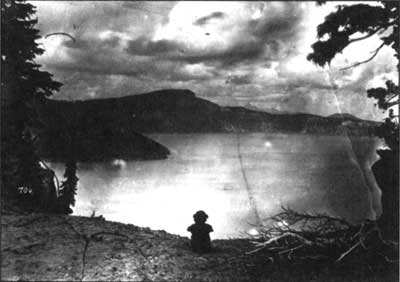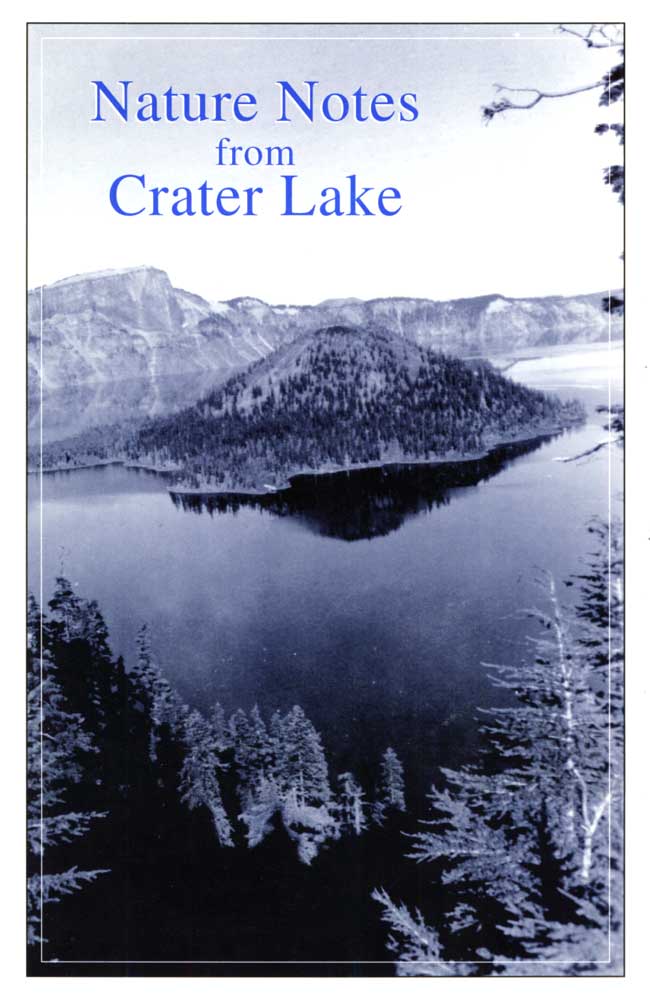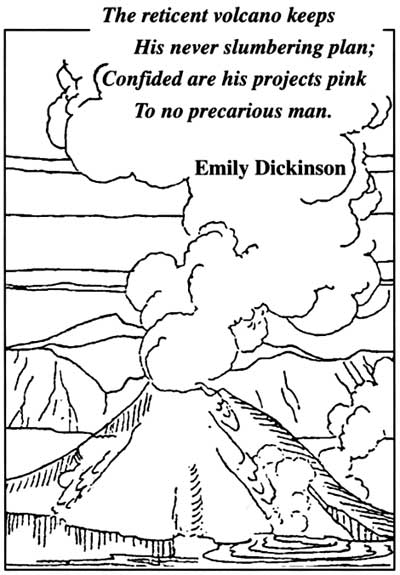Volume 28, 1997
All material courtesy of the National Park Service.These publications can also be found at http://npshistory.com/
Nature Notes is produced by the National Park Service. © 1997
Introduction
The following articles might first appear to be beyond the scope of a publication calling itself “Nature Notes.” Yet what we choose to emphasize in studies or narratives about nature is conditioned by culture and shaped by our selective interaction with the past. How the past confronts the present at Crater Lake is the general theme of this volume, though the broader aim behind all issues of Nature Notes from Crater Lake is to add to the reader’s understanding and appreciation of the park.
Each of these submissions represents an attempt to clarify the past, so as to give it order and meaning in the present. The lead piece by Robert Winthrop emphasizes continuity in how one culture has seen Crater Lake through time by comparing this view with the European idea of sublime landscape. Loosley’s article is intended to reinforce what Winthrop presents as how the settlers saw the park a century ago. My article on the transportation route used to reach Rim Village at that time follows to demonstrate the roads and trails can have symbolic meaning. The device of repeat photography is described by Mastrogiuseppe and Salinas as an ongoing project under the sponsorship of the Crater Lake Natural History Association. On a somewhat different note, Lund’s overview of the Fort Klamath to Crater Lake ski races sets the stage for Astrom’s narrative about what resulted from one of those competitions. The last two pieces represent my attempt to put two features of the designed landscape at Park Headquarters into larger context.
The Crater Lake Natural History Association once again sponsors this edition of Nature Notes from Crater Lake, as part of its ongoing commitment to aid the education and resource management programs of the National Park Service. CLNHA encourages visitors and park employees to become members of the Association, and to join the Friends of Crater Lake National Park. A list of items available for sale can be obtained by writing to the Business Manager, Crater Lake Natural History Association, P.O. Box 157, Crater Lake OR 97604, or by calling (541)594-2211 ext. 499.
The reticent volcano keeps
His never slumbering plan;
Confided are his projects pink
To no precarious man.Emily Dickinson
Crater Lake in Indian Tradition: Sacred Landscapes and Cultural Survival
Introduction
Crater Lake and its environs served a range of uses for the Klamath, Upper Umpqua, and other Indian peoples of the region. The area of what is now Crater Lake National Park was used for both hunting and gathering. Huckleberry Mountain, an important gathering site for the Klamath, lies about ten miles southwest of the lake. Nonetheless, the primary significance of Crater Lake appears to have been as a place of power and peril, renowned as a spirit quest site, yet also feared for the dangerous beings residing in the lake. In short, Crater Lake constituted a sacred landscape, that is, a region distinguished in the traditions of a people by its special spiritual qualities or powers.1
The aim of this paper is to make such an alien reality somewhat more intelligible, both as a matter of cultural interest, and for its relevance to the sensitive management of this remarkable national park. I argue that there are, in fact, significant parallels as well as dramatic differences in Anglo-American and Indian perceptions of such sacred landscapes. Such a comparison can suggest both the degree of common concern for such geographies of refuge and transcendence, and what we as Anglo-Americans could usefully learn from the far more nuanced and complex appreciation of such landscapes inherent in Indian traditions.
Nature as sublime experience
Given the numerous controversies which have arisen since the 1970s over proposed development of lands viewed by Indian peoples as sacred or culturally sensitive, it is worth emphasizing that Anglo-American culture has also seen in nature an avenue for spiritual experience.2 The romantic movement, in particular, strongly influenced the perception of wilderness in nineteenth century America. Denis Cosgrove, in his interesting study of society and symbolic landscapes, noted that in America,
…by the 1820s and 1830s the idea of romantic landscape had invested scenes of wild grandeur with a special significance. They were held by many to be places which declared the great forces of nature, the hand of the creator…. In the context of a religious tradition which stressed individual salvation, the idea of sublime wilderness offered a powerful opportunity for transcendence, a way of appropriating America as a distinctive experience unavailable in Europe.3
Crater Lake, first encountered by Anglo-American travelers in the 1850s, admirably fulfilled the desire for a sublime and inspiring experience of nature. Captain Franklin Sprague, describing his visit in 1865, spoke of the lake’s “majestic beauties” and “awful grandeur.”4 Clarence Dutton remarked in 1886 on the emotional reaction which the lake aroused in its visitors:
It was touching to see the worthy but untutored people, who had ridden a hundred miles in freight-wagons to behold it, vainly striving to keep back tears as they poured forth their exclamations of wonder and joy akin to pain.5
John Wesley Powell, writing in 1888 in support of a bill to create a national park to protect Crater Lake, argued,
The lake itself is a unique object, as much so as Niagara, and the effect which it produces upon the mind of the beholder is at once powerful and enduring. There are probably not many natural objects in the world which impress the average spectator with so deep a sense of the beauty and majesty of nature.6
Similarly, Mark Daniels, former General Superintendent of the National Parks, said of Crater Lake:
The sight of it fills one with more conflicting emotions than any other scene with which I am familiar. It is at once weird, fascinating, enchanting, repellent, of exquisite beauty and at times terrifying in its austere-dignity [sic] and oppressing stillness.7

Enraptured by the sublime: a 19th century visitor at the rim.
Peter Britt photo, 1874. Southern Oregon Historical Society #704, Medford.
What is particularly intriguing about these expressions of geopiety to borrow a term from the geographer Yi-Fu Tuan — is the way in which they manifest both strong similarities and differences with the Indian experience of the Crater Lake region. The similarities lie in the common recognition of an encounter with the alien, the weird, and the numinous in this ancient caldera. Yet the differences are also telling. For the American explorers and settlers, the encounter with Crater Lake appears to have yielded a deep emotional response, but not a deeper knowledge or transformation of self. Such testimonies as these suggest an awareness of the sacred, but it is a mute awareness, a matter of mood. Unlike the Indian visitors to Crater Lake, the Anglo-American travelers lacked the cultural models — the cognitive templates encompassing mythology, ritual practices, and knowledge of localized spirit beings — which allow such encounters to yield a message, to produce lasting understanding and personal change.
This bafflement in the face of mute nature is captured well in a passage from the modern nature writer Edward Abbey. Of his travels in the American Southwest, he says,
I consider the tree, the lonely cloud, the sandstone bedrock on this part of the world and pray — in my fashion — for a vision of truth. I listen for signals from the sun, but that distant music is too high and pure for the human ear.8




